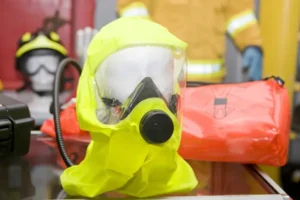U.S. System of Flagging Hazardous Chemicals is Widely Flawed~9 min read
 Facility owners often fail to report while state, county, and local emergency management agencies fail to verify their reporting. Hazardous chemicals are often mis-identified or their locations are mis-reported. This lax oversight and scant reporting is the target of an exclusive report from Reuters.
Facility owners often fail to report while state, county, and local emergency management agencies fail to verify their reporting. Hazardous chemicals are often mis-identified or their locations are mis-reported. This lax oversight and scant reporting is the target of an exclusive report from Reuters.
Read the article From Reuters or read below:
Exclusive: U.S. system for flagging hazardous chemicals is widely flawed
Under the federal Emergency Planning and Community Right-to-Know Act, private and public facilities must issue an inventory listing potentially hazardous chemicals stored on their properties. The inventory, known as a Tier II report, is filled with state, county and local emergency-management officials. The information is then supposed to be made publicly available, to help first responders and nearby residents plan for emergencies.
But facilities across the country often misidentify these chemicals or their location, and sometimes fail to report the existence of the substances altogether.
And except for a handful of states, neither federal nor local authorities are auditing the reports for errors.
Reuters identified dozens of errors in Tier II reports in recent years and found several facilities that failed to report altogether.
Two states – Illinois and Wisconsin – introduced errors into the public databases through which they disclose information from Tier II reports. The reports document the presence of hazardous chemicals, such as ammonium nitrate, lead, sulfuric acid and diesel fuel.
In 2006, clothing company Carhartt Inc failed to report that its plant in Morehead, Kentucky, was storing chlorine on the premises. Two firefighters were exposed and one suffered chemical burns when they shut a leaking valve at the plant without proper safety gear. Carhartt said the plant was shuttered at the time of the leak, but didn’t say why reports weren’t filed.
DAKOTA DATA
This year, a water-treatment facility in Valley City, North Dakota, failed to submit a Tier II report. After Reuters notified state officials, the plant filed a Tier II showing the presence of a host of toxic or explosive materials, including ammonium hydroxide, chlorine, sulfuric acid, sodium hydroxide, sodium permanganate, hydrochloric acid and phosphoric acid. Company officials said they aren’t sure why no reports were filed and are looking into the issue.
In June, homes and businesses in Seward, Illinois, were evacuated for a day after a fire and explosion at Nova-Kem LLC injured one employee and released a plume of smoke containing caustic and toxic chemicals, including chlorine gas. The company, which makes compounds used in high-tech applications, did not report storing hazardous chemicals, according to Dennis Lolli, coordinator of the Winnebago County Emergency Services and Disaster Agency.
No firefighters were injured. But for emergency teams, knowing what chemicals they are facing is critical, Lolli said. “I don’t know why they didn’t” file the reports, he said. “It certainly takes away an advantage.”
Representatives of Nova-Kem didn’t respond to requests for comment.
There are hundreds of thousands of sites nationwide required to report hazardous chemical inventories under the Tier II system. Some 500,000 chemicals are subject to the requirement.
60 DEATHS
Since 2005, accidents at facilities storing 140 Tier II chemicals that have been deemed most dangerous by the Environmental Protection Agency have resulted in approximately 60 deaths, more than 1,300 injuries and more than $1.6 billion in onsite and off-site damages, according to a 2013 EPA report to Congress.
The Tier II system came under scrutiny after the explosion of a fertilizer plant in West, Texas, in April. Minutes after firefighters arrived, 40 tons of ammonium nitrate exploded, killing 11 first responders. Though federal officials say a Tier II report was on file at the fire department, surviving firefighters told Reuters they had never seen a report detailing what chemicals were stored at the factory. Had they known, they may well have stayed outside the blast zone.
Such errors and omissions can go unnoticed for years because the federal regulator that oversees the Tier II system—the EPA—and most state agencies make no effort to verify the data.
EPA officials declined to discuss the reporting program. In a statement, the agency said state and county officials are responsible for ensuring the accuracy of the reports.
The EPA has no system for actively auditing Tier II reports. But it does inspect sites for Tier II reporting issues after receiving a complaint or during a visit to examine compliance with other statutes and regulations.
As a result, the agency has identified at least 95 cases of companies that it says failed to file reports correctly since the beginning of 2012.
One problem that the EPA didn’t spot involved Cleveland-based explosive company Austin Powders. In 2012, its plant in Gonzales, Texas, reported storing as much as 40,000 pounds of ammonium nitrate in the middle of a residential area.
In fact, Austin Powders didn’t have any raw ammonium nitrate in Gonzales, said David True, the company’s president. However, the company should have reported as much as 40,000 pounds of a much more volatile substance, a combination of ammonium nitrate and fuel oil used as an explosive, True said.
‘HUGE PROBLEM’
And the explosives were not located at the reported site. The real storage site was seven miles away and not identified in documents provided to the fire department.
An employee described the chemical incorrectly and inaccurately listed the material as being at the company’s Gonzales office instead of at its storage facility, True said.
Gonzales fire marshal Mike Terry said he had no idea Austin Powders stored tons of explosives at the depot before being informed by a reporter. If firefighters blindly responded to a fire at the site, they could have been killed in an explosion, he said.
“There’s a huge problem with the Tier IIs, no doubt about it,” Terry said.
True agreed the mistake on the Tier II was dangerous. But he said inaccurate reporting is an industry-wide problem that stems from a lack of oversight by state and federal agencies.
“When you do something and you don’t get any feedback, you just sort of do it and get it over with,” he said. “So it wouldn’t surprise me if a lot of people were making mistakes out there.”
Diane Heminway, a safety specialist at the United Steel Workers labor union, said the system has been streamlined so that filing correct reports is simple. And federal law makes it clear which chemicals need to be reported, by mandating that all dangerous chemicals shipped in the United States must be supplied with a Material Safety Data Sheet that details the hazards.
“It’s a matter of filling out a form,” she said. “It’s not a lot of paperwork.”
A few states, including Oregon and Michigan, make an effort to check the reports for errors.
Officials at the Oregon Office of the State Fire Marshal, for example, review nearly 22,000 reports every year and sometimes visit facilities to check inventories.
‘IMPERFECT SYSTEM’
Many states, such as Utah and Kentucky, rely on county officials and local fire departments to verify the reports.
Mark Kaszniak, a safety specialist at the U.S. Chemical Safety Board, a federal investigative body, said local oversight works well in heavily industrialized areas. These tend to have well trained plant employees and first responders, and capable emergency-management departments. These local officials can identify reporting flaws and work with facility managers to correct them.
But in large parts of the country, local fire departments, often staffed by volunteers, can’t afford to employ hazardous-material experts to ensure compliance. “Most of these fire departments just don’t have time to get to all of those inspections, so they rely on the Tier II data to tell them what’s there,” Kaszniak said. “It’s an imperfect system.”
Even when facilities report accurately, states sometimes introduce errors into the system.
The Illinois Emergency Management Agency posted inaccurate hazardous chemical-storage data on its website earlier this year. The data indicated hazardous chemicals at a site even when a facility had stopped reporting chemical stores years ago.
The errors came into play only in cases when data was downloaded for the entire state, which did not happen often, said agency spokeswoman Patti Thompson. The problem was fixed after reporters brought it to the attention of the department.
‘IT’S JUST AN ERROR’
Similar data obtained from the Wisconsin Division of Emergency Management was filled with hundreds of inaccuracies. The data indicated that companies which no longer existed were still storing hazardous chemicals.
The data showed Amron LLC, an ammunition manufacturer, stored hydrogen chloride, sulfuric acid, nitric acid, propane and anhydrous ammonia at a plant in Waukesha, Wisconsin, in 2012. But the company said it shuttered the facility in 1998.
Wisconsin officials could not explain the errors and said they didn’t know how to fix them. They said the inaccurate information wasn’t shared with first responders.
“It’s not that it’s not a big deal, it’s just an error,” said Lori Getter, a crisis-communications manager for the Wisconsin Division of Emergency Management. “We had some computer glitches. Is it threatening the public safety? No.”
Failing to report the existence of a hazardous material may be more dangerous. But reports that falsely flag the presence of a dangerous substance can also create safety risks, said Neal Langerman, chemical-safety officer at the American Chemical Society, a professional organization for chemists.
False-positive reports can drastically change how responders might react to an emergency. If a factory incorrectly reports storing an explosive such as ammonium nitrate, for instance, the fire department may decide to let a fire burn that might otherwise have been extinguished. This could cause injuries to employees, property damage or even a chemical release that threatens the surrounding community.
EMERGENCY CALCULUS
Bloomington, Illinois-based Evergreen FS reported storing as much as 99,999 pounds of ammonium nitrate and anhydrous ammonia at each of three facilities in the state.
But in reality, the farm-supply company stored a diluted form of ammonium nitrate that doesn’t pose an explosion risk, said Brent Owen, the company’s safety and regulatory manager.
Based on the filings, first responders would likely allow a fire burn itself out, fearing an explosion like the one in West, Texas. However, the anhydrous ammonia tanks would then be vulnerable to rupturing and releasing a toxic cloud. In fact, there would be no risk of explosion, and dousing the tanks would be the correct response.
Evergreen FS’s report was technically in compliance, he said: Companies are permitted to report a mixture’s constituent chemicals separately or as a combined substance. But reporting the chemicals separately created an unclear picture for first responders. In the future, the company will report mixtures on Tier II reports, Owen said.
Policing wrong or ambiguous reports is difficult for local and county officials with limited or no real enforcement capacity, said Danny Blevins, chairman of the emergency planning committee in Rowan County, Kentucky, site of the Carhartt chlorine leak.
“We just hope that (the companies) are good neighbors and are filing the proper forms,” he said.
(Edited by Maurice Tamman and Michael Williams)







